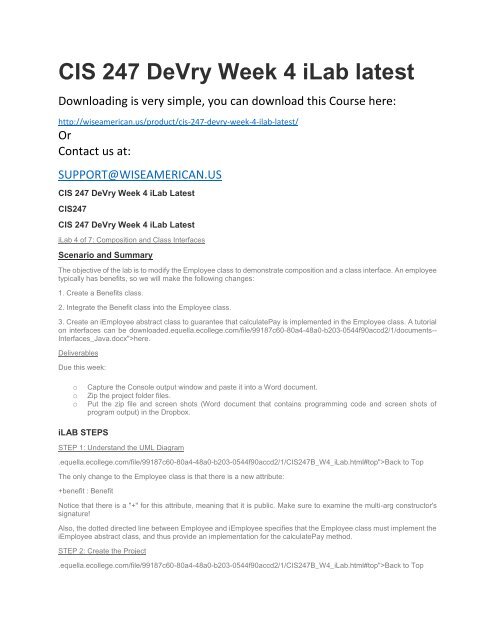CIS 247 DeVry Week 4 iLab latest
You also want an ePaper? Increase the reach of your titles
YUMPU automatically turns print PDFs into web optimized ePapers that Google loves.
<strong>CIS</strong> <strong>247</strong> <strong>DeVry</strong> <strong>Week</strong> 4 <strong>iLab</strong> <strong>latest</strong><br />
Downloading is very simple, you can download this Course here:<br />
http://wiseamerican.us/product/cis-<strong>247</strong>-devry-week-4-ilab-<strong>latest</strong>/<br />
Or<br />
Contact us at:<br />
SUPPORT@WISEAMERICAN.US<br />
<strong>CIS</strong> <strong>247</strong> <strong>DeVry</strong> <strong>Week</strong> 4 <strong>iLab</strong> Latest<br />
<strong>CIS</strong><strong>247</strong><br />
<strong>CIS</strong> <strong>247</strong> <strong>DeVry</strong> <strong>Week</strong> 4 <strong>iLab</strong> Latest<br />
<strong>iLab</strong> 4 of 7: Composition and Class Interfaces<br />
Scenario and Summary<br />
The objective of the lab is to modify the Employee class to demonstrate composition and a class interface. An employee<br />
typically has benefits, so we will make the following changes:<br />
1. Create a Benefits class.<br />
2. Integrate the Benefit class into the Employee class.<br />
3. Create an iEmployee abstract class to guarantee that calculatePay is implemented in the Employee class. A tutorial<br />
on interfaces can be downloaded.equella.ecollege.com/file/99187c60-80a4-48a0-b203-0544f90accd2/1/documents--<br />
Interfaces_Java.docx">here.<br />
Deliverables<br />
Due this week:<br />
o<br />
o<br />
o<br />
Capture the Console output window and paste it into a Word document.<br />
Zip the project folder files.<br />
Put the zip file and screen shots (Word document that contains programming code and screen shots of<br />
program output) in the Dropbox.<br />
iLAB STEPS<br />
STEP 1: Understand the UML Diagram<br />
.equella.ecollege.com/file/99187c60-80a4-48a0-b203-0544f90accd2/1/<strong>CIS</strong><strong>247</strong>B_W4_<strong>iLab</strong>.html#top">Back to Top<br />
The only change to the Employee class is that there is a new attribute:<br />
+benefit : Benefit<br />
Notice that there is a "+" for this attribute, meaning that it is public. Make sure to examine the multi-arg constructor's<br />
signature!<br />
Also, the dotted directed line between Employee and iEmployee specifies that the Employee class must implement the<br />
iEmployee abstract class, and thus provide an implementation for the calculatePay method.<br />
STEP 2: Create the Project<br />
.equella.ecollege.com/file/99187c60-80a4-48a0-b203-0544f90accd2/1/<strong>CIS</strong><strong>247</strong>B_W4_<strong>iLab</strong>.html#top">Back to Top
You will want to use the <strong>Week</strong> 3 project as the starting point for the lab. To do this, you will want to create a new project<br />
by following these steps:<br />
1. Open the same workspace you created for the <strong>Week</strong> 3 project.<br />
2. Create a new project and name it "<strong>CIS</strong><strong>247</strong>B_WK4_Lab_LASTNAME".<br />
3. Copy all the source files from the <strong>Week</strong> 3 project into the <strong>Week</strong> 4 project.<br />
4. Before you move on to the next step, build and execute the <strong>Week</strong> 4 project.<br />
STEP 3: Modify the Employee Class<br />
.equella.ecollege.com/file/99187c60-80a4-48a0-b203-0544f90accd2/1/<strong>CIS</strong><strong>247</strong>B_W4_<strong>iLab</strong>.html#top">Back to Top<br />
1. Using the UML Diagrams from Step 1, create the Benefit class. To get an idea of how to format displayBenefits, take<br />
a look at the output in Step 5.<br />
2. Add a Benefit attribute to the Employee class.<br />
3. Initialize the new Benefit attribute in both Employee constructors. Again, take note of the multi-arg constructors<br />
parameter list!<br />
4. Create the iEmployee interface.<br />
5. Modify the Employee class to implement the new interface so that Employee will have to implement the calculatePay<br />
method.<br />
6. Modify the Employee class to call displayBenefit when displaying Employee information.<br />
STEP 4: Modify the Main Method<br />
.equella.ecollege.com/file/99187c60-80a4-48a0-b203-0544f90accd2/1/<strong>CIS</strong><strong>247</strong>B_W4_<strong>iLab</strong>.html#top">Back to Top<br />
Notice that the Employee class now has a public benefit object inside it. This means that you can access the set<br />
methods of the Benefit object with the following code:<br />
.benefit.<br />
As an example, to set the lifeInsurance attribute inside an Employee object called emp, we could execute the following<br />
code:<br />
emp.benefit.setLifeInsurance(lifeInsurance);<br />
The steps required to modify the Main class are below.<br />
1. Create an Employee object using the default constructor.<br />
2. Prompt for and then set the first name, last name, and gender. Consider using your getInput method from <strong>Week</strong> 1<br />
to obtain data from the user for this step as well as Step 3.<br />
3. Prompt for and then set the dependents and annual salary using the overloaded setters that accept Strings.<br />
4. Prompt for and set healthInsurance, lifeInsurance, and vacation.<br />
5. Using your code from <strong>Week</strong> 1, display a divider that contains the string "Employee Information".<br />
6. Display the Employee Information.<br />
7. Display the number of employees created using getNumEmployees(). Remember to access getNumEmployees<br />
using the class name, not the Employee object.<br />
8. Create a Benefit object called benefit1 using the multi-arg constructor. Use any information you want for health<br />
insurance, life insurance, and vacation.<br />
9. Create another Employee object and use the constructor to fill it with the following: "Mary", "Noia", 'F', 5, 24000.0,<br />
benefit1<br />
10. Using your code from <strong>Week</strong> 1, display a divider that contains the string "Employee Information".
11. Display the employee information.<br />
12. Display the number of employees created using getNumEmployees(). Remember to access getNumEmployees<br />
using the class name, not the Employee object.<br />
STEP 5: Compile and Test<br />
.equella.ecollege.com/file/99187c60-80a4-48a0-b203-0544f90accd2/1/<strong>CIS</strong><strong>247</strong>B_W4_<strong>iLab</strong>.html#top">Back to Top<br />
When done, compile and execute your code. Debug any errors until your code is error-free.<br />
Check your output to ensure that you have the desired output, modify your code as necessary, and rebuild.<br />
Your output should resemble the following:<br />
STEP 6: Submit Deliverables<br />
.equella.ecollege.com/file/99187c60-80a4-48a0-b203-0544f90accd2/1/<strong>CIS</strong><strong>247</strong>B_W4_<strong>iLab</strong>.html#top">Back to Top<br />
Capture the Console output window and paste it into a Word document.<br />
Put the zip file and screen shots (Word document) in the Dropbox.

















